
Welcome to our Club of Amsterdam Journal. “In the future, sexuality may evolve more radically or simply phase-out. Future anthropologists might study the early stages of sexual evolution as an indulgent fixation or a most pleasurable pastime. Regardless, future beings – transhumans or posthumans – will certainly continue to relish in the heat of flesh, physical or virtually simulated, for at least the next few decades. After all, the penis may not become obsolete indeed.” – Natasha Vita More Join our next Season Event and share your thoughts at the future of Sexuality – November 29, 18:30-21:15 Where: Waag Society, Nieuwmarkt 4, 1012 CR Amsterdam [Center of the Nieuwmarkt] |
Felix Bopp, editor-in-chief
Sexuality in the 21st Century?
Internet Porn – The Lucrative Business of Online Sex
- China is the world’s largest exporter of sex toys and novelties, with an estimated 1,000 factories involved in the manufacture of “adult healthcare products”. The Chinese government estimates that about one-third of all adult products and 80 percent of sex toys and condoms sold worldwide are made in China, with annual revenues from sales of Chinese adult products reaching RenMinBi 50 billion ($6.7 billion) in 2006.
- A study found that both men and women reported experiencing an orgasm in about four percent of their sexual dreams. Orgasms were described as being experienced by another dream character in four percent of the women’s sexual dreams, but in none of the male dream reports. Current or past partners were identified in 20 percent of women’s sexual dreams, compared to 14 percent for men, and public figures were twice as likely to be the object of women’s sexual dream content. Multiple sex partners were reported twice as frequently in men’s sexual dreams. – ScienceDaily
- Many older Americans routinely engage in vaginal intercourse, oral sex and masturbation, reported a landmark study into a long-taboo subject. Sexual activity reported among the 3,005 men and women who participated in the survey did decrease with age, particularly among the oldest participants — from 73 percent among those 57 to 64 years of age to 53 percent among those 65 to 74 years of age to 26 percent among those 75 to 85 years of age. … “Hopefully, this opens the door for conversation that might counter stereotypes,” Lindau told reporters in a conference call. “If we regard older people as asexual, particularly as physicians, we really miss an opportunity to do important counseling and interventions for people who may benefit from them.” – CNN
- Virtual porn can be just as, if not more, satisfying than the real thing, asserts Sadako Shikami, a “Second Life” escort, putting emphasis on Second Life’s sex-related users, scripts and objects as being the pinnacle of today’s virtual, interactive sex. Regarding the current state of virtual porn online, “even though a real person created it, it’s just a picture, a painting, a special effect. The main difference between hentai anime or Poser porn and Second Life porn is that there’s a real person behind the avatar, or the furry, or the cartoon,” maintains Sadako. “You can live out your wildest fantasies with a real person who shares them.”

- Development agencies have conventionally viewed sexuality as a health issue. Sex has been regarded as a source of danger, harm and disease. The words `love’, `desire’ and `pleasure’ are absent from the development lexicon. – Institute of Development Studies, Sussex
- Germany’s legal sex industry is estimated to make $18 billion annually [2006].
- Meaningful sex has to be value based. Values are personal. Each situation that has sexual energy in it, involves the whole human being and their entire value system. My values may be different from yours, and I have no right to be the moral judge of anyone’s values. It is important, however, to have core values, and respect them. Without values, we become spiritually bankrupt. Sexual experience will never cause problems and will always be joyful, if lovers share the same values. – Deepak Chopra
- The growth of electronically mediated sex will presumably reduce the number of flesh-to-flesh sex acts. There are millions of people in the industrialized world who spend significant amounts of time and money on Internet porn, sex chat, voyeur cams and interacting with sexual partners through Web cams and audio interfaces.These media will soon be joined by “haptic” and “teledildonic” equipment that will communicate a partner’s caresses and allow you to feel them. Extrapolating to the latter 21st century, when full nanotechnology-based virtual reality is in use, we will be able to have as high-bandwidth a sexual relationship electronically as in the flesh. That will probably mean a lot more casual e-sex and more commercial e-sex. But for those special someones it will also mean more profound sex.Direct control of our brains will also mean that masturbation will be a lot more direct than the current manual methods. We will be able to directly stimulate our sexual pleasure centers pretty much invisibly, and as often as we like. Luckily we won’t have to drive our cars manually anymore, or things could be very dangerous on the road. – James Hughes, Executive Director, IEET, bioethicist and sociologist
- Catching sight of a pretty woman really is enough to throw a man’s decision-making skills into disarray, a study suggests. The men’s performance in the tests showed those who had been exposed to the “sexual cues” were more likely to accept an unfair offer than those who were not. Dr Siegfried DeWitte, one of the researchers who worked on the study, said: “We like to think we are all rational beings, but our research suggests … that people with high testosterone levels are very vulnerable to sexual cues. The researchers are conducting similar tests with women. But so far, they have failed to find a visual stimulus which will affect their behaviour. – The Royal Society
2006 Worldwide Pornography Revenues

Next Event

the future of Sexuality
Thursday, November 29, 2007
Registration: 18:30-19:00, Conference: 19:00-21:15
Where: Waag Society, Nieuwmarkt 4, 1012 CR Amsterdam [Center of the Nieuwmarkt]
The conference language is English.
The speakers are
Marie-Louise Janssen, Lecturer, Department of political science, Gender Studies, University of Amsterdam
Paid Sex and Public Space
Melissa Gira, Editor, Sexerati.com, San Francisco
“The Story of i”: Sex in the Information Age
Luc Sala
Sexuality: the back door into our essence
Moderated by Mirjam Schieveld, Head of the Summer Institute, International School for Humanities and Social Sciences
Supporter: Waag Society
Club of Amsterdam blog
News about the Future
 Positive message for cod in the North Sea The North Sea cod stock declined severely during the late 1990s and early 2000s. The fishing pressure on this stock has been too high for many years and the number of young fish has been very low. Martin Pastoors, ACFM Chair: “Our scientific surveys show that the number of young fish has increased, although only to half of the long term average. These young fish could contribute substantially to the recovery of the North Sea cod stock. We also observe a decrease in mortality which is a welcome signal in response to the management efforts from the past year. But it is not enough. We recommend constraining catches in 2008 to less than 50% of the 2006 catches. And this should include measures to constrain discards and illegal catches. This should give these young fish the opportunity to grow and to reproduce and thereby to contribute to the recovery of this important fish stock.” |

Electronic Nose
A tiny “electronic nose” that MIT researchers have engineered with a novel inkjet printing method could be used to detect hazards including carbon monoxide, harmful industrial solvents and explosives.
The prototype sensor consists of thin layers of hollow spheres made of the ceramic material barium carbonate, which can detect a range of gases. Using a specialized inkjet print head, tiny droplets of barium carbonate or other gas-sensitive materials can be rapidly deposited onto a surface, in any pattern the researchers design.
Tuller, professor in the Department of Materials Science and Engineering: “The way we distinguish between coffee’s and fish’s odor is not that we have one sensor designed to detect coffee and one designed to detect fish, but our nose contains arrays of sensors sensitive to various chemicals. Over time, we train ourselves to know that a certain distribution of vapors corresponds to coffee.”
2007 Horizon Report
 | 2007 Horizon Report a collaboration between The New Media Consortium and the EDUCAUSE Learning initiative |
The annual Horizon Report describes the continuing work of the NMC’s Horizon Project, a research-oriented effort that seeks to identify and describe emerging technologies likely to have a large impact on teaching, learning, or creative expression within higher education.
The Horizon Advisory Board again reviewed key trends in the practice of teaching, learning, and creativity, and ranked those it considered most important for campuses to watch. Trends were identified through a careful analysis of interviews, articles, papers, and published research. The six trends below emerged as most likely to have a significant impact in education in the next five years. They are presented in priority order as ranked by the Advisory Board.
- The environment of higher education is changing rapidly. Costs are rising, budgets are shrinking, and the demand for new services is growing. Student enrollments are declining. There is an increasing need for distance education, with pressure coming not only from nontraditional students seeking flexible options, but from administrative directives to cut costs. The “shape” of the average student is changing, too; more students are working and commuting than ever before, and the residential, full-time student is not necessarily the model for today’s typical student. Higher education faces competition from the for-profit educational sector and an increasing demand by students for instant access and interactive experiences.
- Increasing globalization is changing the way we work, collaborate, and communicate. China, India, and other southeast Asian nations continue to develop skilled researchers and thinkers who contribute significantly to the global body of knowledge and whose work fuels much innovation. Additionally, globalization of communication, entertainment, and information provides students with wider perspectives and resources than ever before, placing them in a new and continually changing learning space.
- Information literacy increasingly should not be considered a given. Contrary to the conventional wisdom, the information literacy skills of new students are not improving as the post-1993 Internet boomlet enters college. At the same time, in a sea of user-created content, collaborative work, and instant access to information of varying quality, the skills of critical thinking, research, and evaluation are increasingly required to make sense of the world.
- Academic review and faculty rewards are increasingly out of sync with new forms of scholarship. The trends toward digital expressions of scholarship and more interdisciplinary and collaborative work continue to move away from the standards of traditional peer-reviewed paper publication. New forms of peer review are emerging, but existing academic practices of specialization and long-honored notions of academic status are persistent barriers to the adoption of new approaches. Given the pace of change, the academy will grow more out of step with how scholarship is actually conducted until constraints imposed by traditional tenure and promotion processes are eased.
- The notions of collective intelligence and mass amateurization are pushing the boundaries of scholarship. Amateur scholars are weighing in on scholarly debates with reasoned if not always expert opinions, and websites like the Wikipedia have caused the very notion of what an expert is to be reconsidered. Hobbyists and enthusiasts are engaged in data collection and field studies that are making real contributions in a great many fields at the same time that they are encouraging debate on what constitutes scholarly work – and who should be doing it. Still to be resolved is the question of how compatible the consensus sapientum and the wisdom of the academy will be.
- Students’ views of what is and what is not technology are increasingly different from those of faculty. From small, flexible software tools to ubiquitous portable devices and instant access, students today experience technology very differently than faculty do, and the gap between students’ view of technology and that of faculty is growing rapidly. Mobile phones, to name just one example, are very different tools to students than to faculty; rather than being mere tools for voice communication, these devices store music, movies, and photos, keep students in touch with their friends by text and voice, and provide access to the wider world of the Internet at any time
Recommended Book

Sexuality – Key Ideas
by Jeffrey Weeks
Most of us are programmed into thinking of our sexuality as a wholly natural feature of life. But sexual relations are just one form of social relations. Sexuality has both a history and a sociology — it is not simply a matter of biological or psychological drives. Drawing on the analysis of Michel Foucault and other key thinkers, this new edition of Sexuality examines the subject in terms of social, moral and political issues, and features new material on AIDS, queer theory and postcolonial perspectives on race.
This book provides an indispensable, comprehensive introduction to the sociology of sexuality, discussing its cultural and socio-historical construction, its relationship with power, and the state’s involvement in its rationalization and regulation.
Piccard closer to the sun
| After four years of research, studies, calculations and simulations, the Solar Impulse project has entered a concrete phase with the construction of an initial prototype with a 61-metre wingspan, referred to by its registration number “HB-SIA”. Its mission is to verify the working hypotheses in practice and to validate the selected construction technologies and procedures. If the results are conclusive, it could make a 36-hour flight – the equivalent of a complete day-night-day cycle – in 2009 without any fuel. Two airplanes on the way to success Construction of the first prototype, the HB-SIA, began in June 2007 and will last until the summer of 2008. Test flights should start in autumn 2008, with the objective of completing the first night flight in 2009.Another plane will then be developed to attempt to fly several 24-hour cycles consecutively, leading to the first trans-Atlantic flight in 2011, and then the first round-the-world flight. 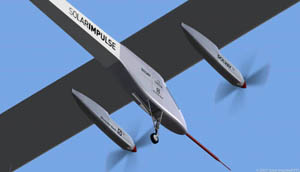 The BH-SIA’s mission This is a “basic” prototype airplane. The instrument panel will be reduced to the essentials, and with a non-pressurized cockpit it will be unable to fly above 8,500m. It will be a first approach at optimizing the balance between energy consumption, weight, performance and controllability. The goal is not to try to fly around the world and indeed the HB-SIA is not built to do so. The objectives at this stage are To validate the computer simulation results, the technological choices and the construction techniques. To test an unexplored area of flight: never before has an airplane succeeded in flying with these size, weight and speed characteristics. To store sufficient solar energy during the daytime to demonstrate the feasibility of a day-night-day cycle (36-hour flight). 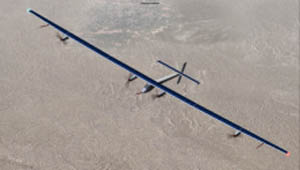 Example of energy efficiency Current solar airplanes are not designed to store energy and therefore have to land in cases of insufficient sunlight (clouds or night time). In so doing they mark the limits of solar energy. Other projects are seeking to fly remote controlled solar drones or hydrogen-powered airplanes. To demonstrate the formidable potential of renewable energies, Solar Impulse intends to place the bar much higher and have a piloted aircraft fly night and day without fuel.But how do we succeed with a mission like this, when we know that with present-day technologies and performances, every square metre of photovoltaic cells can supply only 28 watts – the equivalent of an electric light bulb – to the propeller continuously over a 24-hour period? In other words, how can an airplane fly on the energy consumed by a supermarket window? It is impossible without a complete optimization of the airplane and without a drastic reduction in its energy consumption. Only a machine of disproportionate dimensions (61 metre wingspan) and very light weight (1500 kg) will be able to fly sufficiently slowly (45 km/h) to operate off the available energy!. The Solar Impulse engineers have therefore had to develop a totally new type of airplane, made possible by innovative technologies, in which everything is new, everything is different: aerodynamics, structure, manufacturing methods, type of propulsion, flight domain …In some ways it looks like a large aircraft, in others more like a glider. It has the wingspan of the Airbus A340 and the wing load of paragliders and delta planes. In relation to its size, it must be eight times lighter than that of the best existing glider. This poses the problems of:constructing a structure with this wingspan and such a low weight;finding the balance between stability and manoeuvrability, in other words how to make an airplane of this size and with such a low wing load pilotable? 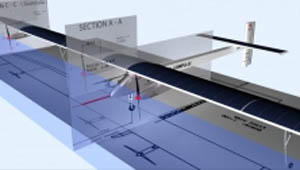 A model of high technology The project will be successful only if it can achieve performances which are still unknown today, achieved by a combination of practical experimentation and complex computer simulations.To achieve this, a multi-disciplinary team of 50 specialists from six countries, based in Dübendorf and Lausanne, assisted by a further roughly 100 outside advisers, are pooling their very specific experiences to create the necessary synergies. It is only by combining the demands of the designers, equipment suppliers, constructors and pilots that an airplane can be built to such atypical specifications. Research initiatives have had to be undertaken and new solutions called into play in a number of sectors – conception, aerodynamics, energy efficiency, structure, composite materials and manufacturing procedures – both for each component individually and for the assembly as a whole.An elegant example is the extreme precision achieved in the use of composite materials: for example stretching carbon sheet just a few tenths of millimetres thick over lengths of up to 20 metres. As the Project CEO, André Borschberg, says, “Anything that doesn’t break is potentially too heavy!”The fragile solar panels also had to be flexible in flight. How do we use cells as both energy generators and wing surface, without breaking when the airplane encounters turbulence?Of course, all this represents the management challenge of bringing together individualists who are as bold as they are creative, getting them to work as a team and motivating suppliers to move beyond their customary limits. 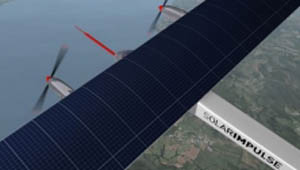 A symbol for our society For Bertrand Piccard, the initiator and president of the project, this airplane is the symbol of the new technologies that our society ought to be capable of rallying behind it in order to economize the energy resources of our planet.Solar Impulse, in this sense, really means what its name says. The sun provides the energy, but the impulse to use it has to be transmitted to people who are ready to receive it and carry it further.In any case, it demonstrates the importance of tomorrow’s adventures being linked to the search for a better quality of life. 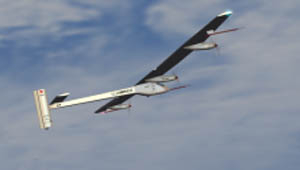 Bertrand Piccard – President and initiator of the project Descended from a dynasty of explorers and scientists who conquered the heights and depths of our planet, Bertrand Piccard seems predestined to perpetuate one of the greatest family adventures of the 20th century. As psychiatrist, aeronaut, internationally renowned public speaker, president of the humanitarian foundation “Winds of Hope” and roving ambassador for the United Nations, he aspires to combining his scientific family heritage with his commitment to exploring the great adventure of life.Pioneer of free flight and of ULM in Europe and winner of the first transatlantic balloon race (the Chrysler Challenge 1992), Bertrand Piccard was also the initiator of the Breitling Orbiter project. His success as flight commander of this first non-stop, round-the-world flight in 1999, catapulted him to the front of the stage as a “savanturier”.Following this success, he received the Legion of Honour, the Olympic Order and the highest distinctions from the International Aeronautic Federation, the National Geographic Society and the Explorer’s Club. Today, Bertrand Piccard takes off with Solar Impulse, in pursuit of a new dream. |
Inventions
Take-A-Seat 3-IN-1
Take-A-Seat is the world’s first vehicle-mounted collapsible chair. It attaches to the vehicle’s receiver hitch while in use and travel. The unit converts to a handy 3-place bike rack and a cargo/cooler carrier.

TTI-Blakemore “Rod Floaters” : Fishing Rod Floater
Have you ever had a fishing rod fall overboard and sink to the bottom of the lake? Have you seen unattended fishing rods pulled into the lake by fish or accidentally thrown into the lake by a child or someone learning to fish and cast their line? Wouldn’t it be nice to have insurance against this happening?
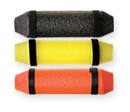
Strike Out Strippz
The amazing new Strike Out Strippz Pitching Glove plus over 60 minutes of video instruction on pitching techniques, mechanics and drills will teach you how to throw strike after strike. Even the professional baseball players, including the Yankees, are using the Strike Out Strippz gloves to improve upon their skills. Every level, from the youngest T-Ball player, elementary to college, and professional will find the benefits to be fool proof – so much so, it is guaranteed to give results. This pitching glove is the easiest way to learn perfect pitching mechanics quickly and simply! It will change young lives by improving their performance and self confidence almost immediately.

USB & lighter combination
We would like to present you the novelty on the USB market… memlite is THE combination of a lighter and an USB flash drive – portable, unique and trendy!
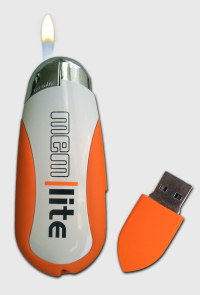
Windsor-Not
The Windsor-Not is a Jewelry Implementation of the Windsor Knot . It works for any mans tie ans is useful for any man that has difficulty typing a traditional tie. It also offers more comfort than a traditional ties with no pressure or discomfort (choking).
The Windsor-Not (Not a Windsor Knot) was invented to help a Man wearing a tie have a painless experience, easy, and more interesting.
There is also a Windsor-Not for women. It is a smaller version and is used to secure scarfs. Made as custom jewelery Items can express the design of any vanity.

Agenda

| November 29 18:30 – 21:15 | the future of Sexuality Location: Waag Society, Nieuwmarkt 4, 1012 CR Amsterdam | |
| January 31 18:30 – 21:15 | the future of Fashion Location: | |
| February 28 18:30 – 21:15 | the future of NanoEnergy Location: | |
| March 27 18:30 – 21:15 | the future of Ecological Architecture Location: Rotterdam | |
| April 24 18:30 – 21:15 | the future of Money Location: | |
| May 29 18:30 – 21:15 | the future of Children Location: Info.nl, Sint Antoniesbreestraat 16, 1011 HB Amsterdam [Next to Nieuwmarkt] | |
| June 26 18:30 – | Taste of Diversity – the future of INDIA Location:  |
Club of Amsterdam Open Business Club
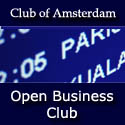 | Club of Amsterdam Open Business Club Are you interested in networking, sharing visions, ideas about your future, the future of your industry, society, discussing issues, which are relevant for yourself as well as for the ‘global’ community? The future starts now – join our online platform … |






Customer Reviews
Thanks for submitting your comment!